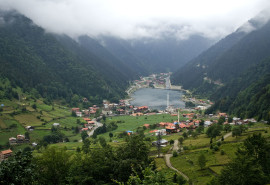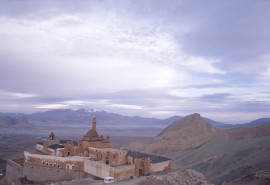Giza Pyramids; Cheops, Chephren and Mykerions
tombGiza is actually a plateau at the edges of the Western Desert, approximately 5.6 mi west of the Nile, and 8 mi southwest of the city center of Cairo. Giza was the necropolis of Egypt's Fourth Dynasty, the era can be described as the "golden age" of the Old Kingdom. Cheops, his son Khafre, and grandson Menkaura have achieved eternal fame by having these pyramids built. In 1979, Giza and Memphis were inscribed on the UNESCO World Heritage List, and Antipater of Sidon listed them as one of the Seven Wonders of the World. It receives approximately 14.7 million visitors per year, and it is possibly one of the most documented historical sites around the world.
The Giza Pyramid Complex includes the Great Pyramid of Giza, the Pyramid of Khafre, and the Pyramid of Menkaure, along with the Great Sphinx of Giza and the Tomb of Queen Khentkaus I. The Great Pyramid is the largest Egyptian pyramid. It was built in the early 26th century BC, in around 27 years, and it is the tomb of pharaoh Khufu. The Pyramid of Khafre is the second-largest pyramid, and like the Great Pyramid, it was built by rock outcropping in the core method. The Pyramid of Menkaure is the smallest pyramid of Giza, even though it is the smallest one, it has been estimated that it was built in 20 years. The human head and lion body of the Sphinx was built during the Fourth Dynasty's reign too. It has been considered that the face represents the pharaoh Khafre and is the oldest monumental sculpture in Egypt. It is also one of the most recognizable statues in the world. The Giza Pyramids are the only ones of the Seven Wonders that have survived to the present day.



-thumb.jpg)

